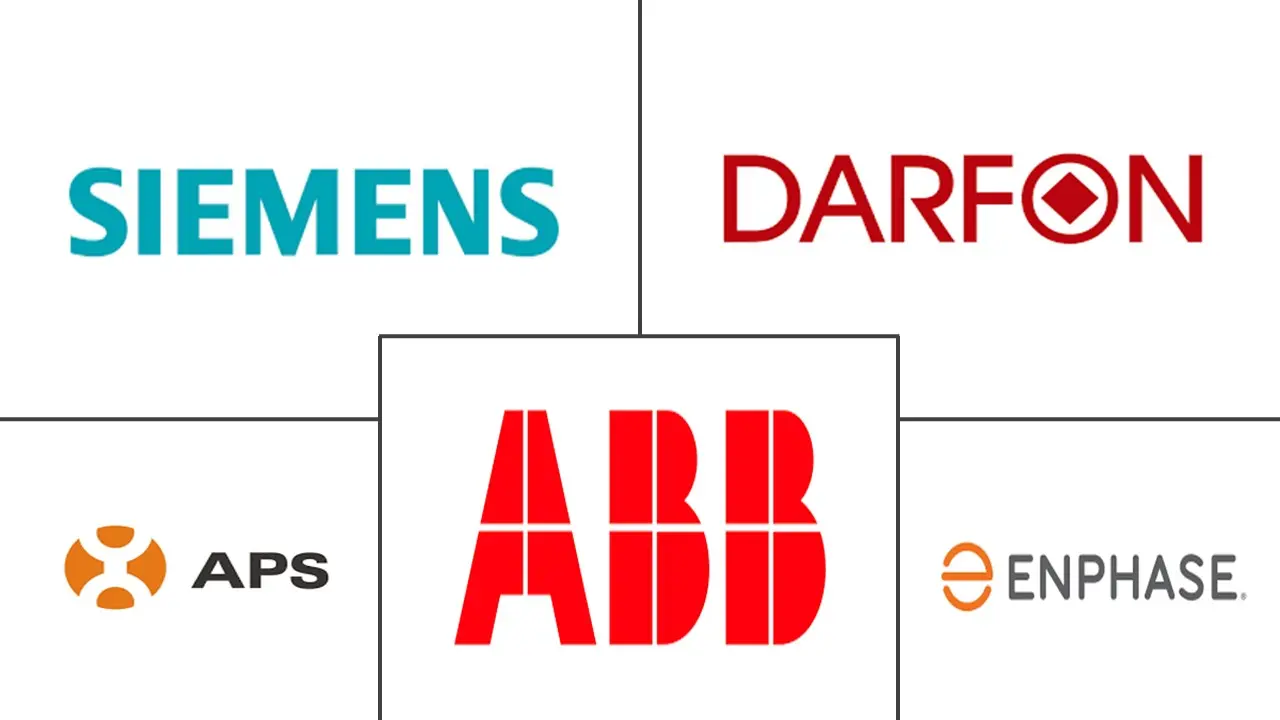Micro Inverter Market Size and Share
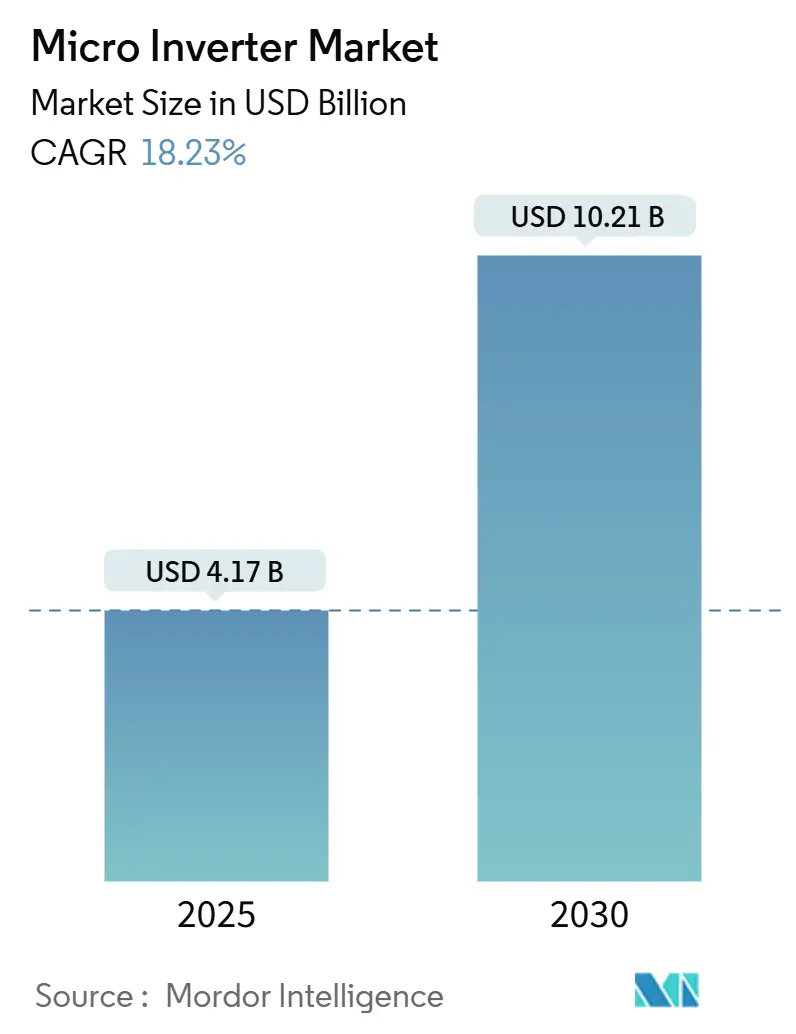
Micro Inverter Market Analysis by Mordor Intelligence
The micro inverter market size is estimated at USD 4.17 billion in 2025 and is forecast to reach USD 10.21 billion by 2030, expanding at a18.23% CAGR over the period. Demand accelerates as module-level power electronics become the default compliance route for rapid-shutdown fire-safety codes, while residential customers increasingly pair rooftop solar with batteries to maximize self-consumption and grid-service revenues. [1]Kelsey Misbrener, “How NEC 690.12 Is Shaping MLPE Adoption,” SolarPowerWorldOnline, solarpowerworldonline.com High-wattage bifacial modules above 600 W drive additional uptake because each panel now needs independent maximum-power-point tracking to harvest variable rear-side gains. Europe’s “balcony solar” phenomenon shows how micro inverters unlock dense urban markets where plug-and-play kits offer renters a pathway to renewable energy. [2]Editorial Desk, “Germany’s Balcony Solar Boom Hits 550K Units,” SaurEnergy, saurenergy.com Simultaneously, the steady migration toward direct-to-consumer sales channels improves margin capture for leading OEMs and tightens customer feedback loops that inform iterative product upgrades.
Key Report Takeaways
- By phase configuration, single-phase systems led with 72% of micro inverter market share in 2024, whereas three-phase platforms are projected to register the fastest 19.1% CAGR through 2030.
- By communication technology, wired solutions held 91% revenue share in 2024; wireless platforms are poised for a 20.4% CAGR to 2030.
- By component, hardware accounted for 58% of the micro inverter market size in 2024, while software and services will advance at 22.7% CAGR over the forecast horizon.
- By sales channel, indirect distribution retained 64% share of the micro inverter market size in 2024; direct sales are set to climb at 21.2% CAGR.
- By application, residential rooftops captured 44% of the micro inverter market size in 2024; utility-scale projects represent the fastest-growing use case with a 21.9% CAGR.
- Geographic split shows North America leading with 38% revenue share in 2024; Asia-Pacific is on track for a 19.5% CAGR.
Global Micro Inverter Market Trends and Insights
Drivers Impact Analysis
| Driver | (~) % Impact on CAGR Forecast | Geographic Relevance | Impact Timeline |
|---|---|---|---|
| Rapid adoption of MLPE driven by NEC 690.12 fire-safety codes | +4.8% | North America and EU | Medium term (2-4 years) |
| Proliferation of 600W+ bifacial PV modules requiring per-panel optimization | +3.2% | Global | Long term (≥ 4 years) |
| Integration of micro-inverters with residential storage ecosystems | +2.7% | North America, Australia, Germany | Medium term (2-4 years) |
| Surge in "balcony solar" installations in Germany and Netherlands | +1.9% | EU core markets | Short term (≤ 2 years) |
| Source: Mordor Intelligence | |||
Rapid Adoption of MLPE Driven by NEC 690.12 Fire-Safety Codes
Fire-safety mandates require rooftop arrays to de-energize conductors within seconds, making micro inverters the simplest path to compliance for most installers. Twenty-five US states enforce the 2020 code update that tightened voltage and time thresholds, effectively displacing string-inverter architectures on new residential systems. Alternative pathways such as rapid-shutdown boxes exist but raise balance-of-system costs and installer complexity, whereas integrated MLPE offers a turnkey solution. European jurisdictions are drafting similar rapid-shutdown language, signaling a global regulatory cascade. As a result, procurement specifications from large installers increasingly list micro inverters as preferred hardware, cementing a durable demand floor regardless of PV module pricing cycles.
Proliferation of 600 W+ Bifacial PV Modules Requiring Per-Panel Optimization
Next-generation bifacial modules deliver up to 25% rear-side gain but only if each panel can track its unique irradiance envelope, a task unsuited to string architectures. Micro inverters provide individual MPPT, unlocking the full bifacial yield profile and preventing one shaded panel from curtailing an entire string. Leading vendors now market 600 W micro inverters with 97% CEC-weighted efficiency, ensuring conversion losses stay below the incremental energy gain. The added capex is increasingly negligible on a per-watt basis as module power ratings climb, making micro inverters economically self-justifying for utility developers concerned with levelized cost of electricity.
Integration of Micro-Inverters with Residential Storage Ecosystems
Rising time-of-use tariffs and blackout anxiety encourage homeowners to add batteries, and micro inverters simplify DC-coupled storage retrofits by eliminating extra conversion stages. Modern platforms embed battery-management firmware and virtual-power-plant interoperability, enabling households to monetize excess capacity through grid services. Modular architecture lets customers start with solar-only arrays and later bolt on storage without rewiring, creating a two-stage sales funnel for OEMs. California’s Self-Generation Incentive Program and similar schemes in Australia and Germany further subsidize solar-plus-storage bundles, reinforcing the micro-inverter value proposition.
Surge in Balcony-Solar Installations in Germany and Netherlands
Germany added 220,000 plug-and-play balcony systems in H1 2024 alone, raising the installed base to over 550,000. Each kit couples one or two 400 W panels with a micro inverter that plugs into a household socket, sidestepping the need for electrical-contractor labor. Regulatory caps of 800 W keep permitting simple, while rising retail electricity prices cut payback times below eight years. The success is replicating in the Netherlands, where recent rule changes sanctioned 600 W kits without utility notification. This consumer-driven segment diversifies the customer base beyond traditional homeowners and normalizes micro inverters as an everyday appliance.
Restraints Impact Analysis
| Restraint | (~) % Impact on CAGR Forecast | Geographic Relevance | Impact Timeline |
|---|---|---|---|
| Scarcity of >1kW three-phase micro-inverter SKUs restrains CandI uptake | -2.1% | Global, particularly Europe and Asia | Long term (≥ 4 years) |
| Thermal derating and reliability issues in Middle-East desert climates | -1.8% | Middle East, North Africa, Southwest US | Medium term (2-4 years) |
| Vendor-locked proprietary communication protocols | -1.4% | Global | Short term (≤ 2 years) |
| Source: Mordor Intelligence | |||
Scarcity of >1 kW Three-Phase Micro-Inverter SKUs Restrains CandI Uptake
Commercial rooftops typically require three-phase feeds, yet few micro-inverter lines scale beyond 1 kW per unit. Compact enclosures struggle to dissipate heat at higher currents, pushing vendors toward costlier power-dense materials or active cooling. This shortage steers installers back to string inverters paired with optimizers for large flat roofs. Manufacturers investing in gallium-nitride switches and advanced thermal paths aim to close the gap, but time-to-market extends beyond the current planning horizons for many CandI developers.
Thermal Derating and Reliability Issues in Middle-East Desert Climates
Field tests in Oman show modules degrade 1.96% annually under combined heat and dust stress, and micro-inverter casings exacerbate internal temperatures by trapping residual heat. Systems throttle output to stay within component ratings, eroding the yield advantage that justifies the higher CAPEX. Installers try mitigating measures such as elevated racking for airflow, but those add structural cost. Without affordable phase-change cooling or similar breakthroughs, micro-inverter penetration in extreme-heat regions will lag global averages.
Segment Analysis
By Phase Type: Three-Phase Momentum Against Single-Phase Dominance
Single-phase models currently underpin 72% of the micro inverter market. Robust household demand, standardized 240 V service, and mature supply chains keep acquisition costs low for installers. At USD 4.17 billion, the 2025 micro inverter market size skews heavily toward this configuration. However, three-phase designs are forecast to expand at 19.1% CAGR, outpacing overall sector growth as CandI rooftops seek module-level monitoring to maximize limited real estate. Developers value redundancy; if one unit fails, only one panel is lost, preserving contractual performance ratios. Early adopters in Europe and Australia cite insurance savings and fewer truck rolls as key ROI levers.
The shift forces manufacturers to re-engineer switching topologies and thermal paths to accommodate higher currents. Firms investing in gallium-nitride FETs report lab efficiencies above 98%, hinting at future cost parity with string solutions. Grid-code revisions that demand voltage-ride-through and reactive-power support will further favor three-phase micro inverters because phase balancing can be managed at panel level, distributing stress more evenly across the array.
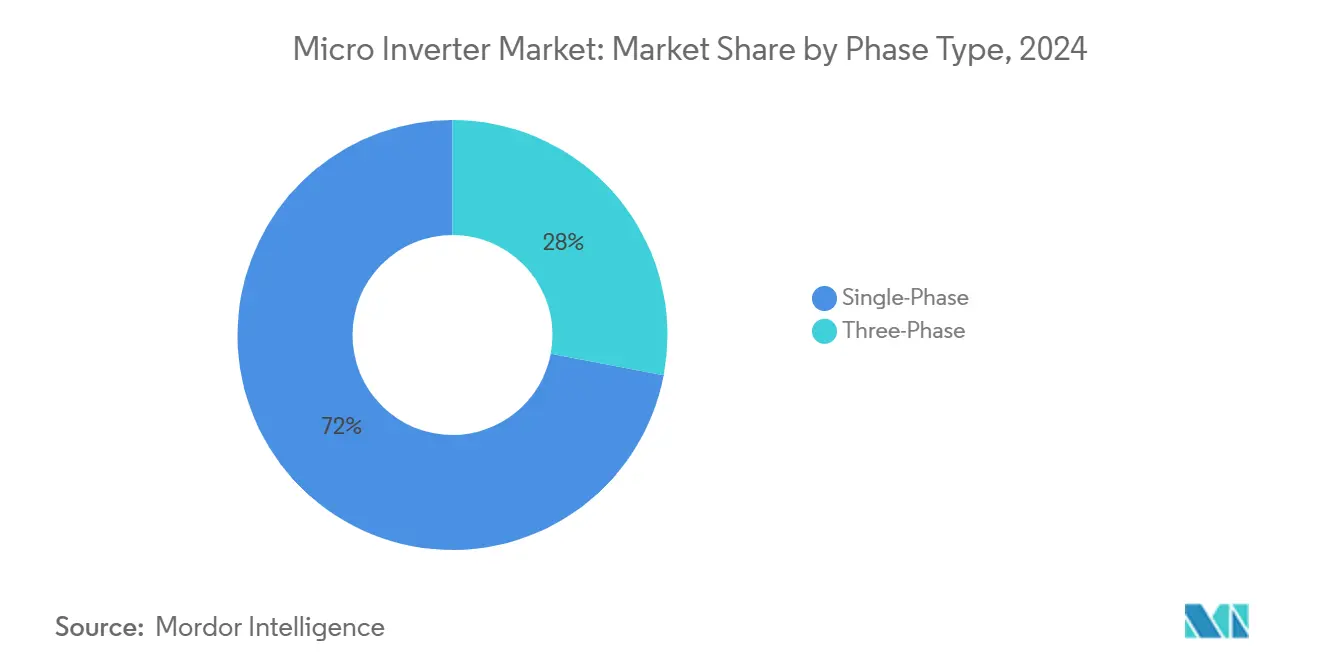
Note: Segment shares of all individual segments available upon report purchase
By Communication Technology: Wired Reliability Meets Wireless Flexibility
Wired architectures dominate with 91% revenue share due to deterministic performance and immunity to RF interference. Installers prefer daisy-chained data lines on large roofs to guarantee monitoring continuity and compliance with warranty terms. Yet wireless platforms are expected to post a 20.4% CAGR as retrofits, complex roofs, and do-it-yourself markets prioritize ease of deployment. The micro inverter industry now collaborates with silicon vendors to embed 802.11ah radios, offering kilometre-scale range on sub-GHz spectrum, which avoids attenuation through roofing materials.
Over the next five years, price-parity milestones will emerge once wireless gateways ship in similar volumes as wired combiner boxes. Cybersecurity remains the gating item; commercial portfolios require proof of end-to-end encryption and over-the-air patching. Vendors that open APIs for fleet-level asset management will gain a stronger channel position with energy-as-a-service operators.
By Component: Software and Services Overtake Hardware Growth
Hardware still anchors 58% of 2024 revenue, but commoditization looms as manufacturing scales. Software tools for predictive analytics and remote OandM form the new battleground, growing at 22.7% CAGR. Each shipped inverter streams granular telemetry, yielding a digital twin that flags soiling, shading, or connection faults long before yield penalties appear. Subscription models pair firmware updates with grid-service algorithms that let asset owners earn capacity payments. As utilities value fast-frequency response, panel-granular bid stacks will become bankable revenue lines, creating differentiation beyond physical efficiency.
OEMs bundle services into warranty extensions, effectively converting capex items into long-tail annuities. The micro inverter market therefore pivots toward platform economics where data ownership sets switching costs. Vendors investing early in AI-driven diagnostics accrue compounding advantages as training datasets expand.
By Sales Channel: Direct Engagement Ups Installer Loyalty
Indirect distribution still holds 64% share because wholesalers finance inventory and offer job-site deliveries. Yet direct-to-installer web shops record a 21.2% CAGR as small contractors seek faster technical support and bulk-pricing transparency. The micro inverter market leverages e-commerce to push firmware updates, training modules, and accessory bundles, deepening wallet share per installer. Manufacturers running certification programs see lower return-merchandise rates and higher net-promoter scores, translating into repeat orders.
Financing partners now embed checkout APIs that let contractors pre-qualify homeowners in minutes, shortening sales cycles. Distributors counter by adding value-added services such as design software and logistics tracking, but the channel balance keeps tilting toward brands with robust digital storefronts.
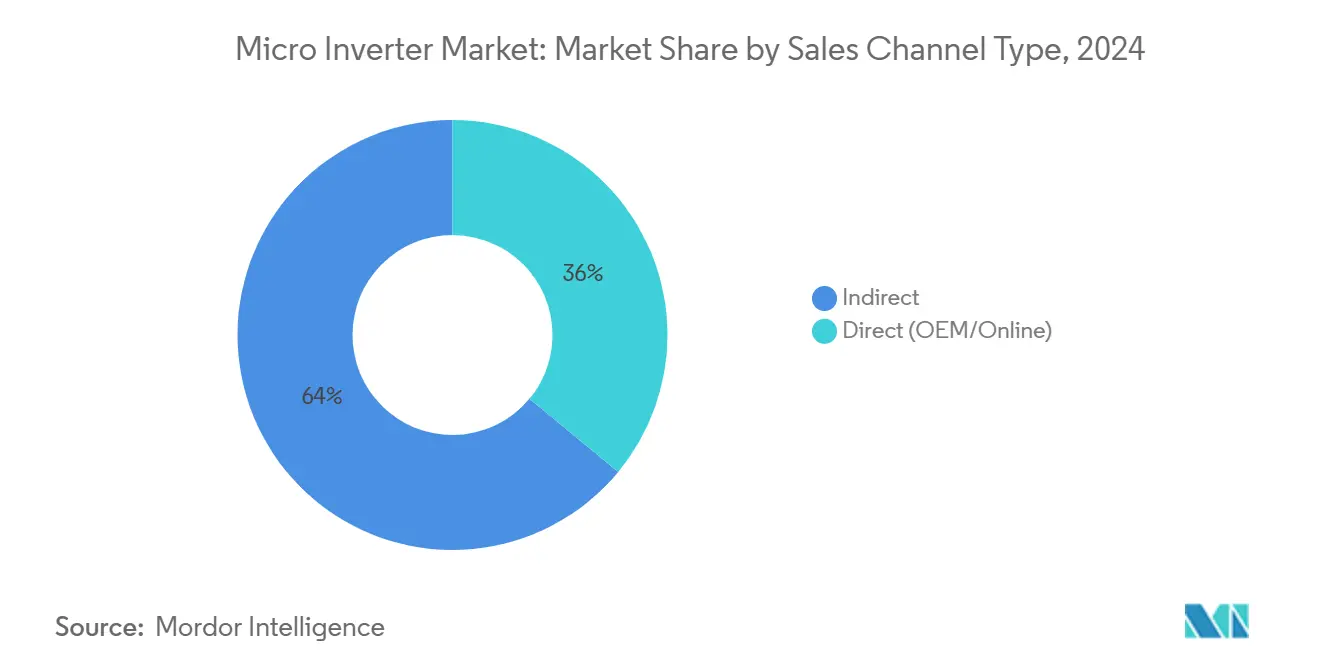
Note: Segment shares of all individual segments available upon report purchase
By Component Application: Utility-Scale Use Cases Accelerate
Residential rooftops delivered 44% of 2024 revenue, yet utility projects are accelerating at 21.9% CAGR. For hilly or heavily shaded terrains, panel-level optimization boosts capacity factors enough to offset higher upfront costs. Developers of 50 MW-plus plants in Japan and the US report operational-expenditure savings from faster fault localization and minimized string-level downtime. [3]U.S. Department of Energy, “Utility-Scale MLPE Case Studies,” energy.gov Meanwhile, commercial rooftops exploit micro inverters to squeeze output under strict weight limits where added racking for optimizers may exceed load thresholds.
Grid codes increasingly remunerate plants that provide voltage regulation and black-start capabilities. Panel-granular inverters can modulate output without the reactive-power penalty typical of large central units. This ancillary revenue layer underpins the economics of micro-inverter-equipped solar farms in mature wholesale markets like ERCOT and CAISO.
Geography Analysis
North America leads with a 38% revenue share, anchored by NEC 690.12 regulations that effectively mandate module-level shutdown. Enphase retains 45% domestic share, though its 2024 revenue slipped to USD 1.33 billion after California’s NEM 3.0 reduced rooftop paybacks. Federal incentives under the Inflation Reduction Act now subsidize inverter manufacturing, aiming to cut the 80% import reliance on Chinese supply chains. [4] Idaho National Laboratory, “Solar Inverter Supply Chain Security,” inl.gov Canada and Mexico, adopting similar safety codes, are expected to boost regional demand further.
Asia-Pacific is the fastest-growing territory at 19.5% CAGR, propelled by India’s commercial-rooftop boom where micro inverters capture 75% of new CandI projects. Australia’s grid-stability incentives reward panel-level reactive-power support; with household solar penetration above 35%, installers champion micro inverters for their granular curtailment features. Chinese vendors such as Hoymiles exploit domestic scale to undercut pricing, while Japan’s premium tariff structure supports higher-end MLPE products.
Europe showcases innovation in urban micro arrays; Germany’s balcony-solar wave illustrates how regulatory simplification triggers mass adoption. The Netherlands follows at 24% residential penetration, while France integrates module-level rapid-shutdown into its 2024 building code. Supply-chain resilience concerns amid geopolitical tensions encourage EU policymakers to promote regional manufacturing, potentially realigning sourcing away from Asia.
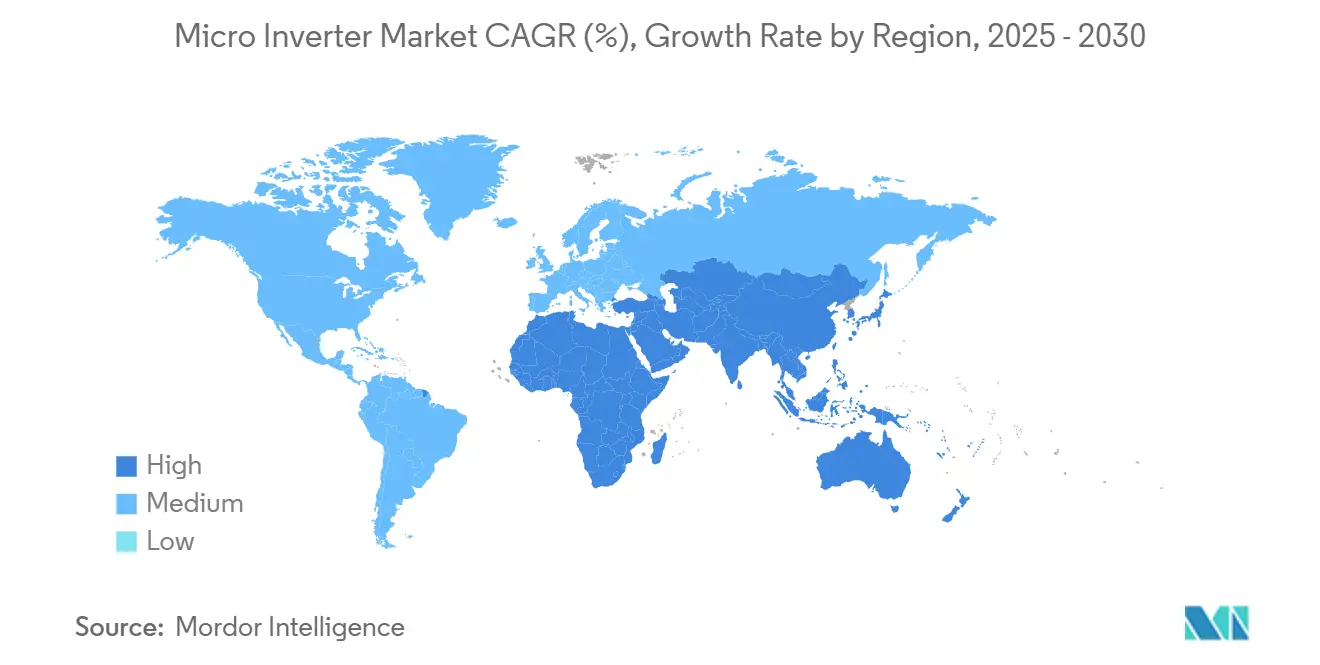
Competitive Landscape
The sector displays moderate concentration: the top five producers control roughly 70% of global shipments, giving the micro inverter market a balanced competitive dynamic. Enphase’s 45% US position reflects first-mover patents on high-frequency transformer topology and an integrated software stack. SolarEdge holds 28% share globally by bundling power optimizers with hybrid inverters, gaining traction in markets where three-phase service is common. Hoymiles scales rapidly in price-sensitive regions through OEM white-label agreements, challenging incumbents on cost.
Strategic moves emphasize vertical integration. Enphase’s acquisition of battery firm ClipperCreek created a closed ecosystem spanning generation, storage, and EV charging. SolarEdge bought Kokam to internalize lithium-cell supply and hedge against battery shortages. Smaller entrants specialize: APSystems targets three-phase SKUs above 960 W, seeking CandI white space, while TSUN leverages GaN switches for sub-1 kg form factors aimed at balcony kits. Patent litigation remains active, but cross-licensing agreements suggest industry convergence on shared standards over the long term.
R&D pipelines focus on higher power density via wide-bandgap semiconductors and silicon-carbide drivers. Communication layers move toward open protocols after the Linux Foundation spotlighted interoperability gaps, but brands still monetize proprietary clouds until customer pressure forces change. Suppliers that can simultaneously boost efficiency, offer bankable warranties, and open data APIs stand to consolidate share as asset owners scale portfolios across continents.
Micro Inverter Industry Leaders
-
Enphase Energy Inc.
-
Siemens AG
-
Altenergy Power Systems (APsystems)
-
ABB Ltd.
-
Darfon Electronics Corp.
- *Disclaimer: Major Players sorted in no particular order
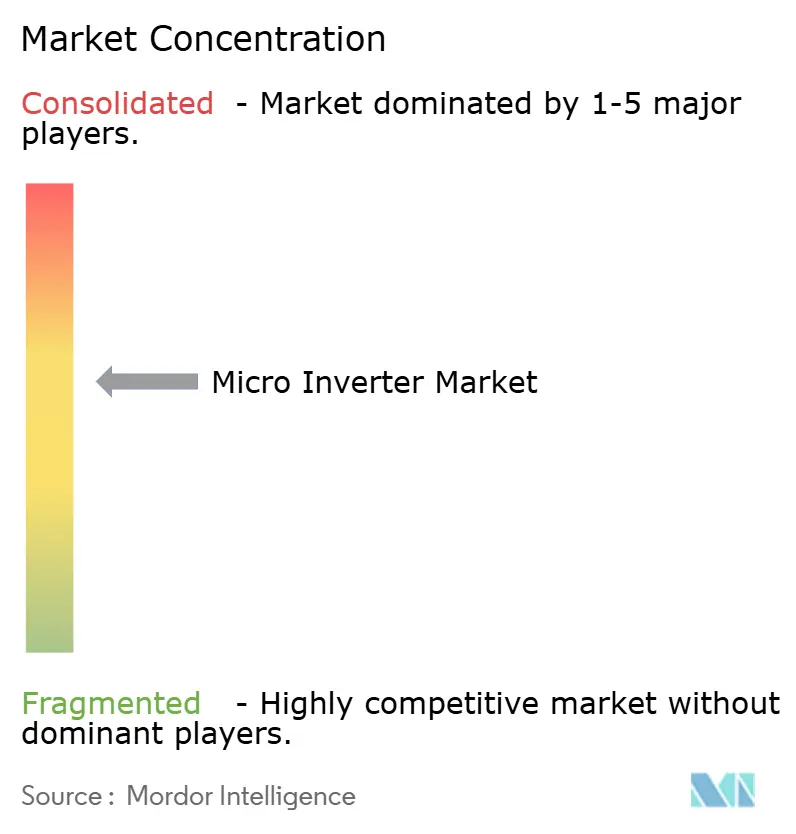
Recent Industry Developments
- April 2025: Enphase Energy reported resilient Q1 2025 results and reaffirmed its strategy to counter US policy headwinds by accelerating Europe and Australia rollouts, while doubling down on storage attach-rates to raise lifetime customer value.
- February 2025: Enphase posted Q4 2024 revenue of USD 382.7 million, maintaining a 47.3% gross margin; management cited direct sales expansion and software subscriptions as buffers against lower US rooftop volumes.
- January 2025: Germany’s balcony-solar tally exceeded 550,000 units, validating micro-inverter-enabled plug-and-play kits; policy makers signaled higher wattage limits for 2026, a catalyst for OEMs scaling 800 W SKUs.
- December 2024: The US DOE traced 80% of domestic inverter supply to Chinese factories, underscoring energy-security risk; OEMs announced joint-venture lines in Texas, targeting 2026 production under IRA tax credits.
Research Methodology Framework and Report Scope
Market Definitions and Key Coverage
According to Mordor Intelligence, we treat the micro-inverter market as all revenue that equipment makers earn from purpose-built, panel-level devices that convert the direct current of a single photovoltaic module into grid-synchronous alternating current and ship with embedded or gateway-based monitoring. Reported value reflects first commercial sale to distributors, installers, or end users and is expressed in constant 2024 U.S. dollars.
Scope exclusion: The study leaves out string, central, hybrid, and optimizer-only inverters, as well as revenue from installation labor, extended warranties, or third-party monitoring platforms.
Segmentation Overview
- By Phase Type
- Single-Phase
- Three-Phase
- By Communication Technology
- Wired
- Wireless
- By Component
- Hardware
- Software and Services
- By Sales Channel
- Direct (OEM/Online)
- Indirect (Distributors/Installers)
- By Application
- Residential Rooftop
- Commercial and Industrial Rooftop
- PV Power Plant / Utility-Scale
- By Geography
- North America
- United States
- Canada
- Mexico
- Europe
- United Kingdom
- Germany
- France
- Netherlands
- Nordics
- Rest of Europe
- Asia-Pacific
- China
- Japan
- India
- South Korea
- Australia
- Rest of Asia-Pacific
- South America
- Brazil
- Argentina
- Rest of South America
- Middle East and Africa
- Middle East
- GCC
- Turkey
- Rest of Middle East
- Africa
- South Africa
- Nigeria
- Rest of Africa
- Middle East
- North America
Detailed Research Methodology and Data Validation
Primary Research
We spoke with inverter designers, rooftop installers, electrical inspectors, and component suppliers across North America, Europe, and Asia-Pacific. These conversations verified typical selling prices, regional code adoption speeds, and the share of new rooftop systems opting for module-level power electronics, which helped us fine-tune penetration assumptions.
Desk Research
Our analysts canvassed open-source energy statistics from the International Energy Agency, U.S. Energy Information Administration, and Eurostat; cross-checked shipment records from Harmonized Tariff Schedule codes on Volza; and reviewed peer-reviewed work logged in IEEE Xplore. Company financials and channel commentary were retrieved through D&B Hoovers, while Dow Jones Factiva supplied press and tender updates that confirmed contract volumes. Trade association white papers from SolarPower Europe and the National Renewable Energy Laboratory added policy timelines and technology cost curves.
These sources illustrate rather than exhaust the references consulted; many additional datasets and industry notes fed the evidence base.
Market-Sizing & Forecasting
A top-down model converts national residential PV additions (MW) into addressable micro-inverter volume through penetration ratios that vary by roof pitch, shading index, and safety-code enforcement, which are then priced using blended ASPs gathered from distributor quotes. Select bottom-up checks, supplier revenue roll-ups, and sampled installer invoices align totals. Key variables include cumulative installed PV capacity, average panel wattage, NEC 690.12 adoption timelines, quarterly ASP erosion, and sales-channel mix. Multivariate regression applies these drivers to project demand through 2030, while scenario analysis tests policy and price shocks. Gaps in bottom-up data are bridged with region-weighted averages agreed upon during primary interviews.
Data Validation & Update Cycle
Outputs pass variance checks against independent shipment trackers before an analyst peer review signs off. Models refresh every twelve months, with interim revisions triggered by material events such as tariff shifts or major code updates, ensuring buyers always receive the latest snapshot.
Why Our Micro Inverter Baseline Commands Reliability
Published numbers often diverge because firms use different product baskets, pricing ladders, and forecast cadences. Our disciplined scope, annual refresh, and dual-lens validation keep the baseline steady, yet responsive.
Key gap drivers arise when others blend hybrid or optimizer units with micro-inverters, inflate values by import duties, or restrict coverage to mature regions only; differences our model avoids.
Benchmark comparison
| Market Size | Anonymized source | Primary gap driver |
|---|---|---|
| USD 4.17 bn | Mordor Intelligence | - |
| USD 5.78 bn | Global Consultancy A | Includes hybrid & optimizer products |
| USD 6.04 bn | Industry Analytics Firm B | Uses supplier ASP plus landed-cost uplift |
| USD 4.11 bn | Independent Research Org C | Excludes Asia-Pacific & LatAm demand |
The comparison shows that while figures vary, Mordor's carefully bounded definition and regularly vetted variables give decision-makers a dependable midpoint they can trace back to transparent, repeatable steps.
Key Questions Answered in the Report
What is the current size of the micro inverter market?
The micro inverter market size is USD 4.17 billion in 2025 and is projected to reach USD 10.21 billion by 2030 at an 18.23% CAGR.
Why are micro inverters preferred under NEC 690.12?
NEC 690.12 rapid-shutdown rules mandate safe voltage within seconds; micro inverters meet this requirement inherently, avoiding extra shutdown devices.
Which segment is growing fastest within the micro inverter market?
Three-phase micro inverters for commercial roofs show the fastest 19.1% CAGR as developers seek panel-level optimization on large installations.
How do micro inverters enhance bifacial module performance?
Each inverter conducts independent MPPT, capturing variable rear-side gains and preventing one shaded panel from throttling an entire string.
What regions show the strongest growth momentum?
Asia-Pacific leads with a 19.5% CAGR, driven by India’s C&I rooftop boom and Australia’s high residential penetration.
How concentrated is the competitive landscape?
A concentration score of 6 indicates that while leaders like Enphase and SolarEdge dominate, niche players still have room to compete on specialized features.
Page last updated on:
